parent nodes: Mitos gregos
Mapas gerais dos deuses gregos
index do verbete
genealogia completa

f.: http://ludios.org/greekgods/ Clique no link para ver a imagem em tamanho maior:rel://files/_J8Y739SJSD3YQUV4PI86.jpg
mapa 1: protogenoi e titãs
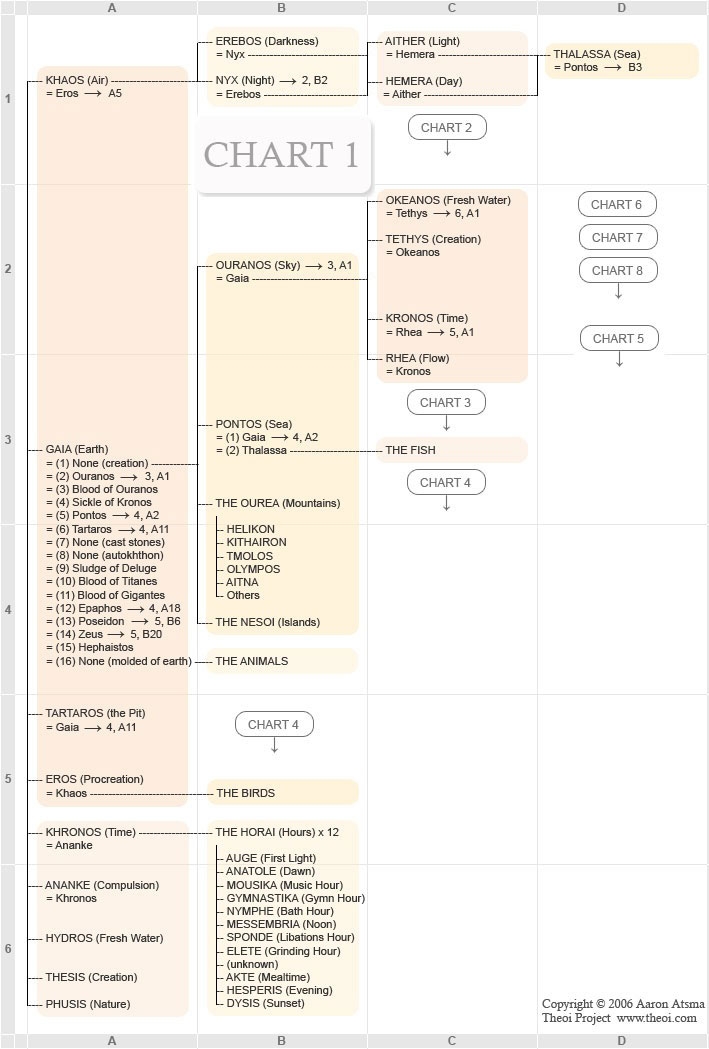
f.: http://www.theoi.com/Tree1.html Clique no link para ver a imagem em tamanho maior:rel://files/_7WCIGFCAXBO674MIIE7O.jpg
mapa 2: filhos da noite
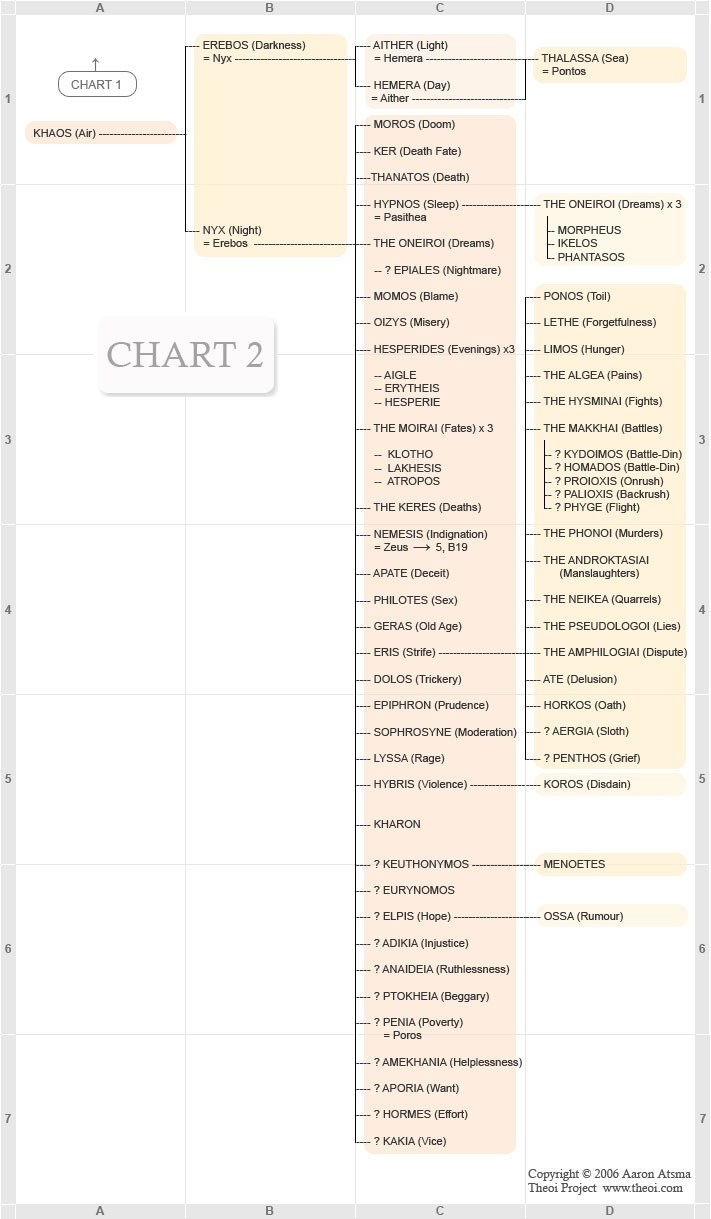
Clique no link para ver a imagem em tamanho maior:rel://files/_G3HV9ZDRJXGKMBJ85V5A.jpg
mapa 3: titãs e filhos do céu

Clique no link para ver a imagem em tamanho maior:rel://files/_FXCWEYYUMDXUCBQNL44R.jpg
mapa 4: filhos da terra e do mar

Clique no link para ver a imagem em tamanho maior:rel://files/_9DCMAL0VN0T3LWJZNB7K.jpg
mapa 5: olímpicos

Clique no link para ver a imagem em tamanho maior:rel://files/_YF7P3T8GC4N83N1DL97K.jpg
mapa 7: ninfas e rios

Clique no link para ver a imagem em tamanho maior:rel://files/_M95SPLGMIFGQNQIVCZCP.jpg
teogonia de hesíodo
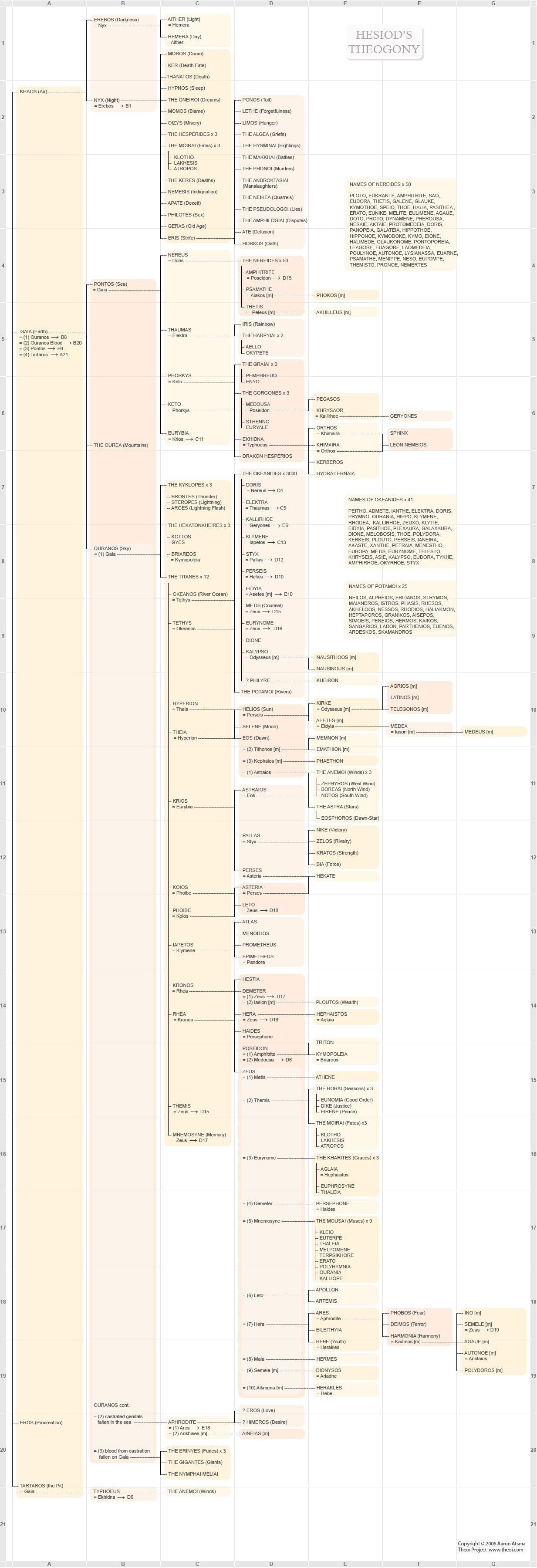
http://www.theoi.com/TreeHesiod.html Clique no link para ver a imagem em tamanho maior:rel://files/_IWFGQHW107APHDUZLDIZ.jpg
Notas:
(1) Khaos in Hesiod's poem is the air, literally the "gap" between heaven and earth. He uses the word clearly as such in his description of the Titan-War where, through the flaming lightning bolts of Zeus "all the land (gaia) seethed, and Okeanos' streams and the unfruitful sea (pontos) . . . flame unspeakable rose to the bright upper air (aither) . . . astounding heat seized the gap (khaos)."
(2) At the start of the genealogies Hesiod says "at the first Khaos came to be, but next wide-bossomed Gaia (Earth) . . . and dim Tartaros in the depths of the wide-pathed Earth, and Eros." Some interpret this to mean that Gaia and the others were born of, or emerged from, Khaos. However most read this passage to say that the five emerged sequentially but independently of one another. Indeed, Hesiod goes on to specifically describe the beings sprung of Khaos: Erebos (Darkness) and Nyx (Night).
(3) According to Hesiod the spirit-children of Nyx and Eris were born without a sire.
(4) The three Moirai (Fates) appear twice in the genealogies of Hesiod, and in both places their names are given. Their first appearance is as daughters of Nyx (without father). They are later described as daughters of Zeus and Themis.
(5) Hesiod says that at the birth of Aphrodite "Eros and comely Himeros followed her at her birth at the first." This passage is sometimes interpreted to mean (including by some classical writers) that a younger Eros and Himeros were either born together with Aphrodite from the castrated genitals of Ouranos, or that they were born from the goddess at her birth, in a tradition which describes her as emerging fully-grown and pregnant from the sea .
(6) The poet describes three sets of beings born from the blood of the castrated Ouranos: the Erinyes, the Gigantes, and the Nymphai Meliai. The Gigantes (literally the "earth-born") are probably the Kouretes (Curetes) and the Meliai the Idaian Nymphs, both protectors of the infant Zeus. There is a certain symmetry that the children born of Kronos' crime--the castration of his own father--should be the ones to ensure his eventual downfall through the agent of Zeus. Several later authors also call the Kouretes Gigantes and the nurses of Zeus Melian Nymphs.
Others believe that these Gigantes were those which later made war on the gods. However the Giant War appears to be simply a later alternative to Hesiod's Titanomachia and/or the attack of the hundred-formed giant Typhoeus upon Olympos .
(7) The parentage of Ekhidna is not entirely clear. Hesiod says that "she bare another monster . . . Ekhidna". The "she" in this sentence may be referring back to either to Keto (mated with Phorkys), or Kallirhoe (who coupled with Khrysaor). It is usually assumed that the poet is referring to Keto, another child of whose is mentioned after the description of Ekhidan and her brood.
(8) The Sphinx and Nemean Lion are also described as being born of a vague "she" who was coupled with the hound Orthros. The poet may here be referring back to either Ekhidna or Khimaira. However considering that the offspring are both leonine, the lioness Khimaira makes the most likely candidate for mother.
(9) In the list of Nereides, Hesiod mentions a goddess named Kymatolege, who alongside Kymothoe and Amphitrite had the power to still the waves. There is no Kymatolege named elsewhere in the genealogies, and her name is surplus to the fifty Nereides. Presumably she is either the same as the Nereid Kymo, or Kymopoleia, a daughter of Poseidon, named elsewhere in the Theogony.
(10) Hera is described as giving birth to Hephaistos without father, in reaction to Zeus' producing a motherless child, Athene, from his head.
(11) The centaur Kheiron is mentioned in passing in the passage describing the son of Jason and Medea. Hesiod calls him a son of Philyre. She was presumably one of the Okeanides, as attested by later authors, however she is absent from the poet's list of these goddesses.
(12) The text of the Theogony is believed to contain some interpolations by later writers. Especially the section describing the mortal sons of goddesses coupled with men.
principais deuses
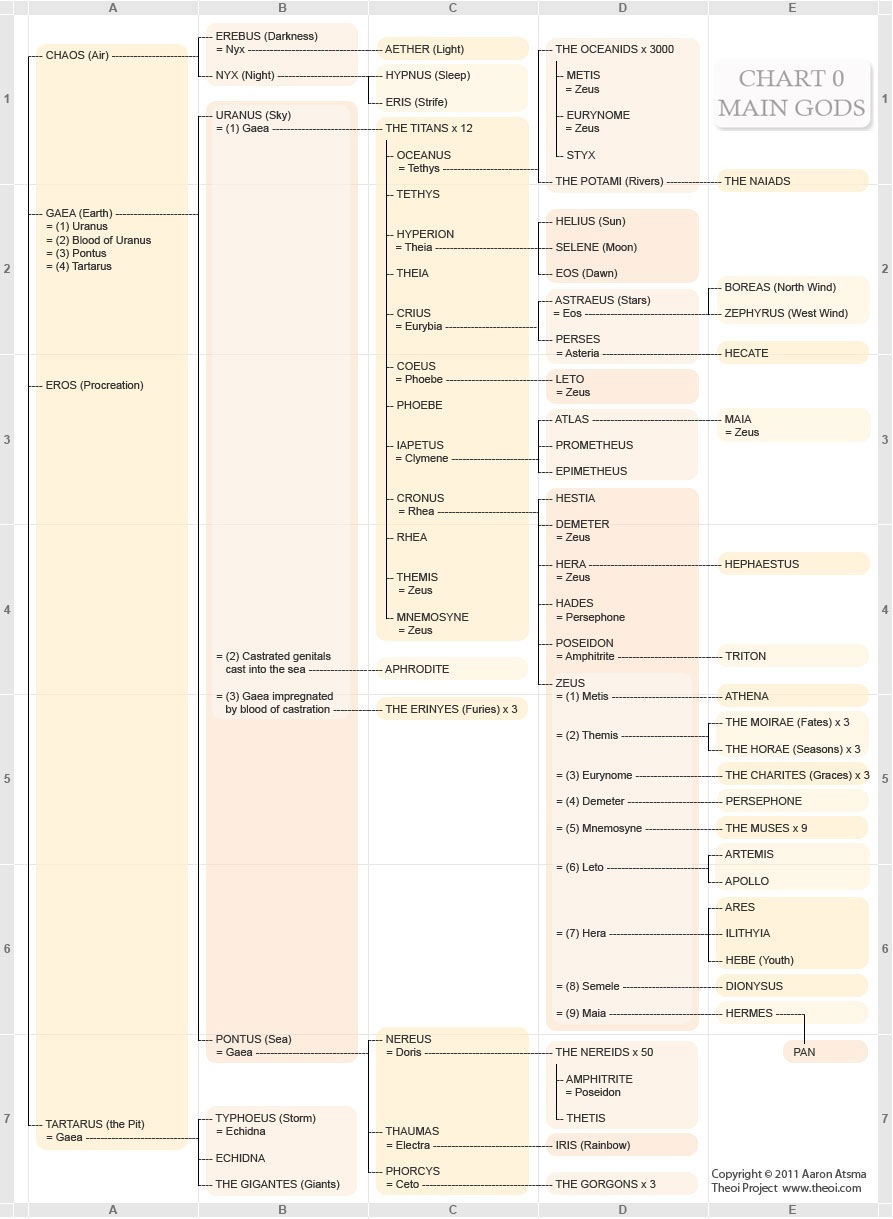
f.: http://www.theoi.com/Tree0Roman.html Clique no link para ver a imagem em tamanho maior:rel://files/_6MMYCF975S4W9T86A64G.jpg
com nomes romanos
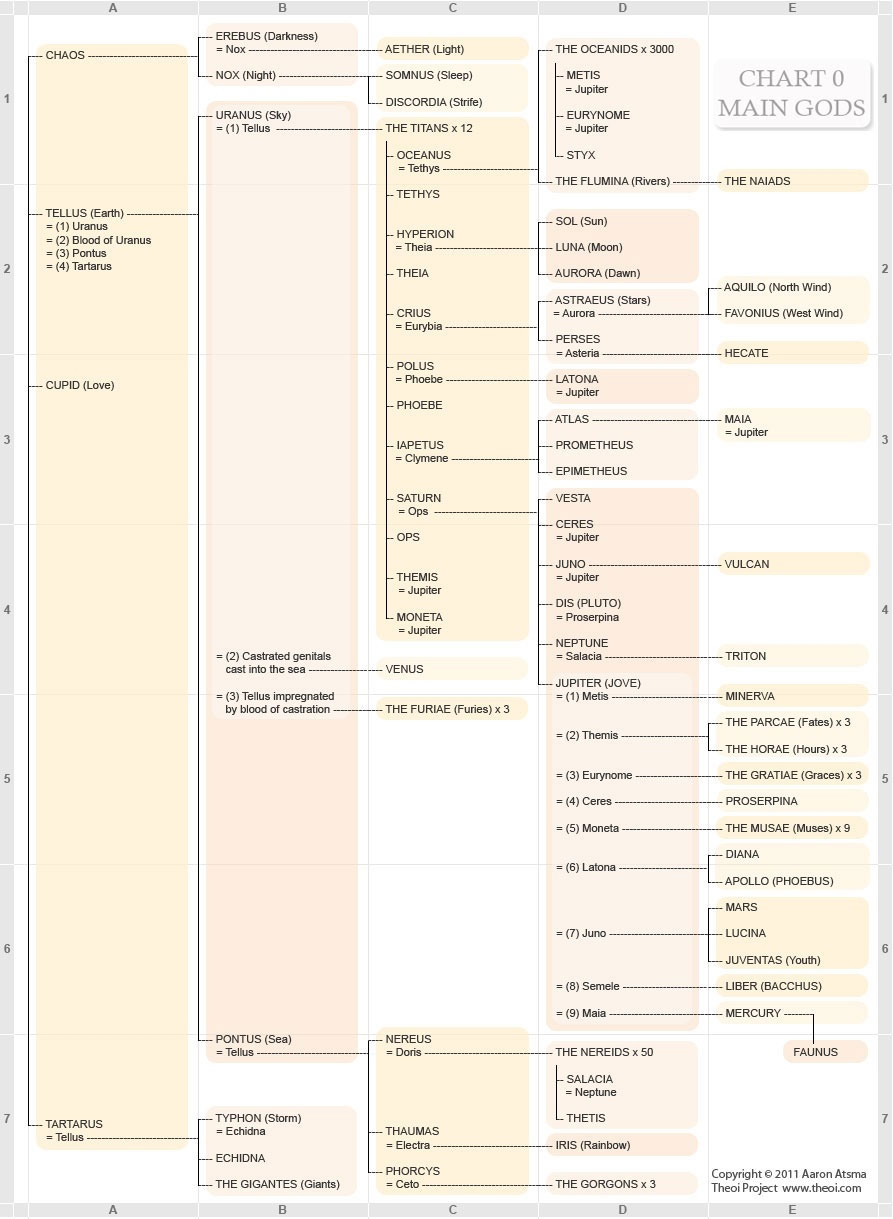
f.: http://www.theoi.com/Tree0Roman.html Clique no link para ver a imagem em tamanho maior:rel://files/_C89TDK477V7BFUVXQC33.jpg
ENCYCLOPAEDIA V. 51-0 (11/04/2016, 10h24m.), com 2567 verbetes e 2173 imagens.
INI | ROL | IGC | DSÍ | FDL | NAR | RAO | IRE | GLO | MIT | MET | PHI | PSI | ART | HIS | ??? 








